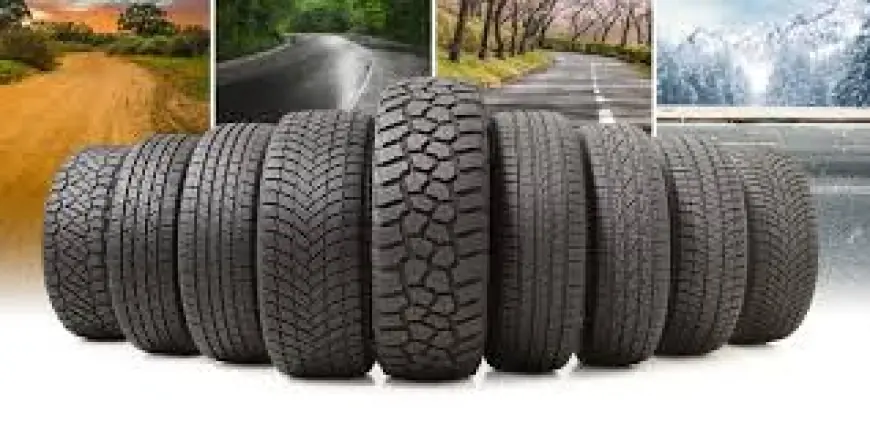Tire Market 2030 Key Players, Trends, and Forecast Data
The Global tire market was valued at USD 279.80 billion in 2024 and is estimated to reach USD 447.08 billion by 2030, growing with a CAGR a of 8.2% by value in the forecast years.

Introduction
The Global tire market industry is at a pivotal moment. As of 2024, it reached a marketplace valuation of USD 279.80 billion, and forecasts indicate that it will expand to USD 447.08 billion by 2030—at a compound annual growth rate (CAGR) of 8.2% between 2020 and 2030. This dramatic surge reflects multiple converging forces: the exponential rise in vehicle ownership (both personal and commercial), innovative tire technologies, growing concerns over fuel efficiency and sustainability, stringent safety regulations, and heightened demand in emerging vehicle categories like electric vehicles (EVs), motorcycles, off-the-road vehicles (OTRs), and others.
In this comprehensive analysis, we explore how the tire market is reshaped by technological innovation, sustainability trends, and regional growth dynamics. The content delves into Drivers, Emerging Trends, Industry Key Highlights, Future Outlook, and provides a concise list of 10 direct benefits of the research report, concluding with a robust Competitive Analysis of industry leaders.
Industry Key Highlights
- Market Size & Forecast
- 2024 valuation: USD 279.80 billion
- Projected 2030 valuation: USD 447.08 billion
- Sustained growth with CAGR of 8.2%
- Vehicle Market Segmentation
- Passenger cars: comfort, fuel efficiency, quiet operation
- Light commercial vehicles (LCVs): load-bearing, durability, value
- Medium & heavy commercial vehicles (M&H CVs): endurance over long distances
- Two- and three-wheelers: grip, maneuverability, road handling
- Off-the-road (OTR): specialized for mining, agriculture, construction
- Tire Construction Types
- Radial: predominates market due to performance & fuel efficiency
- Bias: continues in niche markets/cost-sensitive segments
- Demand Categories
- OEM: original equipment for new vehicles
- Replacement: aftermarket driven by wear and tear
- Regional Dynamics
- Asia-Pacific leads growth—faster than any other region by 2024
- Europe & North America maintain mature, innovative markets
- Latin America, Middle East, Africa steadily growing
- Key Drivers of Growth
- Surge in global vehicle production and ownership
- Rise of EVs, requiring specialized tire solutions
- Advancements in smart, IoT-enabled tires
- Growing pressure for sustainable and recycled materials
- Stricter global emissions and safety regulations
Download Free Sample Report: https://www.techsciresearch.com/sample-report.aspx?cid=3057
Drivers of Industry Growth
1. Rising Vehicle Ownership
Urbanization, expanded middle-class incomes, and robust automotive manufacturing in China, India, Southeast Asia, and Latin America underpin strong tire demand.
2. Electric Vehicle Revolution
EVs present a major opportunity. Their heavier weight, instant torque delivery, and efficiency demands inspire tires engineered with low rolling resistance, reinforced durability, and optimized weight.
3. Technological Innovations
- Smart tires with sensors (pressure, temp, wear, performance)
- Integration of AI & IoT for tire-health monitoring, predictive maintenance, and lifespan optimization
- Advanced materials—use of silica, carbon composites—boosting lifespan and fuel-efficiency
- Emphasis on recyclable and bio-based rubber
4. Regulatory Drivers
Globally, policies targeting lower carbon footprints, reduced noise pollution, and road safety have prompted innovations in tire labeling, materials, and design.
5. Infrastructure Expansion & Demand for OTR Tires
Rapid infrastructural projects in emerging markets (e.g., road construction in India and Africa) energize demand for heavy-duty OTR tires.
Emerging Trends Shaping the Market
Smart & Connected Tires
Manufacturers embed sensors, RFID, or NFC into treads, offering real-time data on tire pressure and temperature. Benefits include safety, preemptive maintenance, and improved fuel economy, appealing to commercial fleets and premium vehicle buyers.
Green Innovation & Sustainability
Recycled rubber, renewable materials, and nanotechnology-enhanced compounds are gaining traction—very much aligned with consumer demand and ESG mandates.
Run-flat & Self-healing Tire Technologies
These innovations offer short-term mobility after puncture, minimizing disruption and merely enhancing roadside safety.
Lightweight Material Adoption
Carbon fiber, Kevlar, and silica-infused compounds help lower unsprung mass, boost energy efficiency, and improve EV range.
E-Commerce Expansion
Tires are increasingly sold online via e-commerce marketplaces and digital showrooms. Convenience, quick delivery, and installation services are reshaping distribution.
OEM and Fleet Partnerships
OEMs co-develop specialized tires tailored for EVs or high-tech vehicles. Fleet buyers (e.g., logistics companies) are entering long-term agreements with tier-1 tire suppliers, optimizing cost and performance.
Market Segmentation Insights
By Vehicle Type
- Passenger Cars: Largest market share driven by private vehicle ownership. SUVs and crossovers with specialty tires (all-season, winter) are gaining popularity.
- LCVs & M&H CVs: Global logistics expansion fuels OEM demand. Weight, mileage, load capacity, and fuel efficiency are key selection factors.
- Two- & Three-Wheelers: Critical in Asian markets due to affordability and urban mobility. Tire supply for scooters, motorcycles, and auto-rickshaws plays a significant role.
- OTR: Demand driven by construction and mining. Manufacturers like Michelin and Bridgestone supply large radial tires for heavy machinery.
By Construction Type
- Radial Tires: >80% market due to better handling, fuel economy, and lifespan.
- Bias Tires: Persist in agricultural equipment, budget models, and regions with traditional preferences.
By Demand Category
- OEM: Brand visibility and long-term partnerships make this segment a stable market.
- Replacement: Dependent on mileage, wear, and seasonal changes. Fueled by inflation, DIY consumer trends, and aftermarket quality products.
Regional Overview & Expansion
Asia‑Pacific: The Epicenter
Countries like China, India, Indonesia, Thailand, and Vietnam lead in growth. EV penetration and construction activity are accelerating tire demand; the Asia EV market also pushes for EV-specific tires.
North America & Europe
These markets continue to innovate—mostly high-performance, eco-friendly, and premium-tier tires, including winter/snow and smart variants.
Latin America, Middle East & Africa
Steady growth in line with urbanization, construction, and infrastructure markets; demand largely depends on commercial and OTR tire segments.
Emerging Trends in Detail
1. AI‑Powered Predictive Maintenance
Commercial fleets adopt tire data analytics to reduce operational costs. Predictive wear algorithms connect to fleet dashboards, enabling proactive replacements.
2. Shift to Sustainable & Recyclable Materials
Manufacturers incorporate recycled rubber, agricultural by-product modifiers (like rice husk silica), and improved rubber compounding techniques. The emphasis is also on reducing material waste during production.
3. Run‑Flat & Self‑Sealing Technology
Beyond convenience, these tires reduce roadside risks and support premium vehicle safety systems.
4. Integrated Digital Platforms
Digital distribution channels and service apps (shop, install, track) are becoming essential tools in acquiring and retaining customers.
5. OEM Collaborations with EV Manufacturers
Specialized tires co-developed for EV models (e.g., Tesla, VW ID, Nissan Leaf) optimize range and noise—close OEM partnerships ensure timely alignment.
Drivers Revisited
- Urbanization & Mobility: Rapidly growing metropolises demand diverse vehicle types and tires.
- EV & Fleet Shift: Taxi fleets (Uber, Ola) push EV adoption, spurning new tire sub-segments.
- Regulatory Pressure: Lower rolling resistance mandates, composition disclosure—100% recycled by 2035 in some markets.
- Consumer Preferences: Comfort, low noise, all‑weather readiness shape buying patterns.
- Infrastructure Projects: Public works in APAC drive OTR tire consumption.
Future Outlook (2025–2030)
Looking ahead, the industry is expected to:
- Achieve growth rates: OCAGR ~8.2%, reaching nearly USD 450 billion by 2030.
- Witness accelerated adoption of EV-tailored tires—low rolling resistance and reinforced design.
- Expand smart tire solutions—integrating 5G, vehicle-to-infrastructure (V2I) tech.
- Embrace a circular economy—manufacturers pledge to collect and reuse up to 90% of tires by 2035.
- Shift distribution online—digital marketplaces to represent 25–30% of sales by 2030.
- Introduce regulatory crackdowns—noise/environment standards, and carbon labeling by tire weight.
10 Benefits of the Research Report
- Market Size & Projection Clarity – Understand total value and forecast trajectory.
- Vehicle-Segment Granularity – Analyze by passenger, commercial, two/three‑wheeler, and OTR.
- Construction-Type Comparison – Radial versus bias—pricing, growth rates, regional adoption.
- Demand Category Insights – OEM vs aftermarket demand drivers.
- Regional Deep Dives – Growth profiles for Asia-Pacific, Europe, North America, LATAM, MEA.
- Emerging Tech Analysis – Smart tires, recycled materials, EV-specific innovations.
- Regulatory Mapping – Tire emission labeling, performance standards, government policies.
- Competitive Benchmarking – Performance, innovation, and strategic positioning of leading firms.
- Partnership and M&A Overview – Key collaborations, alliances, and future strategic moves.
- Risk & Opportunity Matrix – SWOT-style analysis across segments and markets.
Competitive Analysis
The global tire market is deeply competitive, with both legacy powerhouses and rising challengers:
Bridgestone Corporation
- Pioneer of run-flat and low rolling resistance tires. Major OEM supplier.
- Heavy R&D focusing on EV tire design and sustainability.
Michelin Group
- Innovator of bio-based rubber and self-sealing tire technology.
- Widespread global reach and premium brand image.
Goodyear Tire and Rubber Company
- Emphasizes “intelligent” tire systems using sensor data.
- Strong aftermarket positioning with brand loyalty.
Continental AG
- Leader in smart tires and sensor tech—esp. in the commercial vehicle segment.
- Actively partnering with automakers for tire-as-a-service platforms.
Pirelli
- Gravity towards performance and luxury vehicle segments.
- EV-specific and ultra-high performance tire range.
Hankook, Yokohama, Sumitomo, Apollo
- Focus on cost-efficient, durable products tailored to APAC markets.
- Aligning portfolios with OEMs and EV manufacturers regionally.
Emerging Players
- Zhongce, Linglong, Giti – Aggressive capacity expansion in China/Southeast Asia.
- Sustainable practices (natural rubber sourcing, eco-tire rollouts).
Strategic Partnerships
- Michelin + OTR fleet pilots for autonomous mining
- Goodyear + automotive OEMs for embedded-sensor tires
- Bridgestone + EV startups for co-development projects
Industry Challenges & Mitigation
- Raw Material Volatility – Natural rubber & oil prices fluctuate; vertical integration and synthetic blends help.
- Stringent Regulations – Dual pressure to innovate and comply; costly certifications needed.
- EV Weight & Requirements – Heavier batteries mean increased rolling resistance—necessitating specialized tire lines.
- Market Saturation in Developed Nations – OEM replacement tires often conflict on pricing and margins.
- Overcapacity in Asia – May lead to pricing wars; diversification of product mix helps stabilize revenue.
Future Outlook
By 2030, the tire industry is expected to exhibit notable transformation:
- Smart Tires Go Mainstream: Embedded sensors and fleet analytics reshape maintenance and safety.
- Circular Economy & Sustainability: Reuse/recycle programs become pervasive and often mandated.
- EV-First Product Design: Dedicated EV tire tiers prioritized by OEMs and regulators.
- E-Commerce Dominance: Direct-to-consumer models with digital experiences rise.
- Performance & All-Climate Premiums: Performance tires, winter/all-season variants gain market share.
Conclusion
The global tire market, currently valued near USD 280 billion, is on the verge of profound transformation. Over the next decade, it will expand to over USD 440 billion, propelled by surging vehicle demand, electrification, sustainable innovations, and digital transformation. Disruptive trends—smart tires, circular materials, EV specialization—are opening opportunities while creating new forms of competitive pressure. Companies that combine agility, innovation, eco-consciousness, and digital capabilities will define the industry’s next phase.
Contact Us-
Mr. Ken Mathews
708 Third Avenue,
Manhattan, NY,
New York – 10017
Tel: +1-646-360-1656
Email: [email protected]
Website: www.techsciresearch.com
What's Your Reaction?
 Like
0
Like
0
 Dislike
0
Dislike
0
 Love
0
Love
0
 Funny
0
Funny
0
 Angry
0
Angry
0
 Sad
0
Sad
0
 Wow
0
Wow
0




















































